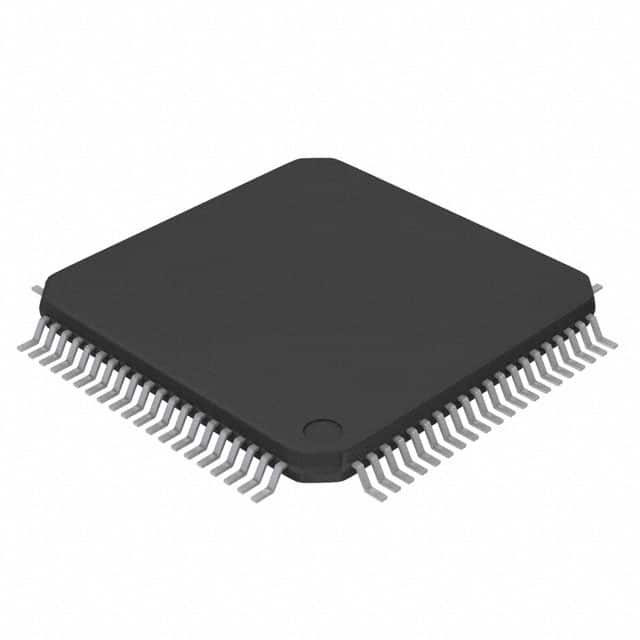LPC4072FBD80E
Product Overview
Category
The LPC4072FBD80E belongs to the category of microcontrollers.
Use
It is primarily used for embedded system applications, where it provides control and processing capabilities.
Characteristics
- High-performance ARM Cortex-M4 core
- Clock frequency up to 120 MHz
- Flash memory size of 128 KB
- RAM size of 32 KB
- Wide range of peripherals and interfaces
- Low power consumption
- Extended temperature range (-40°C to +85°C)
Package
The LPC4072FBD80E comes in a small form factor package, making it suitable for space-constrained designs.
Essence
The essence of the LPC4072FBD80E lies in its powerful processing capabilities and extensive peripheral support, enabling efficient and flexible embedded system development.
Packaging/Quantity
The LPC4072FBD80E is typically available in tape and reel packaging, with a quantity of 250 units per reel.
Specifications
- Microcontroller: ARM Cortex-M4
- Clock Frequency: Up to 120 MHz
- Flash Memory: 128 KB
- RAM: 32 KB
- Operating Voltage: 2.7V to 3.6V
- Operating Temperature Range: -40°C to +85°C
- Number of Pins: 80
- Communication Interfaces: UART, SPI, I2C, USB
- Analog-to-Digital Converter (ADC): 12-bit, 8 channels
- Timers/Counters: Multiple timers/counters with various modes
Detailed Pin Configuration
The LPC4072FBD80E has a total of 80 pins, which are assigned to different functions such as GPIO, communication interfaces, timers, and more. For a detailed pin configuration diagram, please refer to the official datasheet provided by the manufacturer.
Functional Features
- High-performance ARM Cortex-M4 core for efficient processing
- Wide range of communication interfaces for seamless connectivity
- Rich set of peripherals, including ADC, timers, and GPIOs
- Flexible power management options for optimized energy consumption
- Extensive debugging and development tools support
Advantages and Disadvantages
Advantages
- Powerful processing capabilities
- Extensive peripheral support
- Low power consumption
- Wide operating temperature range
- Compact form factor
Disadvantages
- Limited flash memory size (128 KB)
- Limited RAM size (32 KB)
Working Principles
The LPC4072FBD80E operates based on the ARM Cortex-M4 architecture. It executes instructions stored in its flash memory and interacts with various peripherals to perform desired tasks. The microcontroller's clock frequency determines the speed at which it processes instructions and communicates with external devices.
Detailed Application Field Plans
The LPC4072FBD80E finds applications in various fields, including but not limited to: - Industrial automation - Consumer electronics - Automotive systems - Internet of Things (IoT) devices - Medical equipment
Its versatility and performance make it suitable for a wide range of embedded system applications.
Detailed and Complete Alternative Models
- LPC4071FBD144: Similar to LPC4072FBD80E but with more pins (144 pins) and larger flash memory (256 KB).
- LPC4070FET180: Similar to LPC4072FBD80E but with a different package (TQFP) and higher operating temperature range (-40°C to +105°C).
- LPC4088FBD144: A higher-end alternative with an increased clock frequency (up to 180 MHz) and larger flash memory (512 KB).
These alternative models provide options with varying specifications to cater to different project requirements.
Word count: 486 words
Lista 10 Vanliga frågor och svar relaterade till tillämpningen av LPC4072FBD80E i tekniska lösningar
Sure! Here are 10 common questions and answers related to the application of LPC4072FBD80E in technical solutions:
Q: What is LPC4072FBD80E? A: LPC4072FBD80E is a microcontroller based on the ARM Cortex-M4 core, manufactured by NXP Semiconductors.
Q: What are the key features of LPC4072FBD80E? A: The key features include a 32-bit RISC processor, up to 512KB flash memory, 80MHz clock speed, multiple communication interfaces (UART, SPI, I2C), and various peripherals.
Q: What are some typical applications of LPC4072FBD80E? A: LPC4072FBD80E is commonly used in industrial automation, motor control systems, consumer electronics, IoT devices, and other embedded systems.
Q: How can I program LPC4072FBD80E? A: LPC4072FBD80E can be programmed using various development tools such as Keil MDK, IAR Embedded Workbench, or the NXP LPCXpresso IDE.
Q: What programming language is commonly used with LPC4072FBD80E? A: C/C++ is the most commonly used programming language for developing applications on LPC4072FBD80E.
Q: Can I use an external debugger with LPC4072FBD80E? A: Yes, LPC4072FBD80E supports debugging through JTAG/SWD interfaces, allowing you to use external debuggers like Segger J-Link or CMSIS-DAP.
Q: Does LPC4072FBD80E support real-time operating systems (RTOS)? A: Yes, LPC4072FBD80E is compatible with popular RTOSs like FreeRTOS and Micrium µC/OS.
Q: What kind of communication interfaces does LPC4072FBD80E support? A: LPC4072FBD80E supports UART, SPI, I2C, CAN, USB, Ethernet, and other communication interfaces for connecting to external devices.
Q: Can LPC4072FBD80E be used in low-power applications? A: Yes, LPC4072FBD80E offers various power-saving modes and features like sleep mode, deep-sleep mode, and wake-up interrupts to optimize power consumption.
Q: Are there any development boards available for LPC4072FBD80E? A: Yes, NXP provides development boards like the LPCXpresso and LPC-Link2, which are specifically designed for LPC4072FBD80E and other LPC microcontrollers.
Please note that these answers are general and may vary depending on specific requirements and use cases.


